new posts in all blogs
Viewing: Blog Posts Tagged with: Mariko Tamaki, Most Recent at Top [Help]
Results 1 - 13 of 13
How to use this Page
You are viewing the most recent posts tagged with the words: Mariko Tamaki in the JacketFlap blog reader. What is a tag? Think of a tag as a keyword or category label. Tags can both help you find posts on JacketFlap.com as well as provide an easy way for you to "remember" and classify posts for later recall. Try adding a tag yourself by clicking "Add a tag" below a post's header. Scroll down through the list of Recent Posts in the left column and click on a post title that sounds interesting. You can view all posts from a specific blog by clicking the Blog name in the right column, or you can click a 'More Posts from this Blog' link in any individual post.

By: Samantha McGinnis,
on 5/17/2016
Blog:
First Book
(
Login to Add to MyJacketFlap)
JacketFlap tags:
graphic novels,
Book Lists,
science,
Caldecott,
The Liberation of Gabriel King,
Loree Griffin Burns,
summer reads,
Citizen Scientists,
Mariko Tamaki,
Deborah Underwood,
Johanna Kerby,
A Balloon for Isabel,
graduation gifts,
This One Summer,
Inside First Book,
Our Recommendations,
K.L.Going,
Little Pink Pup,
Add a tag
The school year is coming to a close and it’s time to stock up for summer reading. We have five great books for you!
This month, our book list features a sweet story about an unconventional animal family, an adorable picture book that celebrates determination, a nonfiction guide to becoming a backyard scientist, and a book that teaches you how to stand up to their fears. For mature readers, the first-ever graphic novel to receive a Caldecott Honor will make for an engrossing read.
For Pre-K –K (Ages 3-6):
 Little Pink Pup by Johanna Kerby
Little Pink Pup by Johanna Kerby
Get ready to say “Awww!” every time you turn the page! The real-life photos of a tiny little pig being raised by dachshunds is a heart-warming story that promotes acceptance and reminds us that everyone deserves love.
For 1st and 2nd Grade (Ages 6-8):
 A Balloon for Isabel by Deborah Underwood
A Balloon for Isabel by Deborah Underwood
This adorable picture book is both a perfect read-aloud and an ideal graduation gift! It’s a joyful celebration of creativity, determination, and creative problem-solving. We can’t get enough of this one!
For 3rd & 4th grade (Ages 8-10):
 Citizen Scientists by Loree Griffin Burns
Citizen Scientists by Loree Griffin Burns
Anyone can be a scientist in this kid-friendly, non-fiction gem! Kids will learn how to observe, conduct research, collect data, and be part of four unique scientific discoveries that can happen anywhere — in a backyard, a field, or even a city park.
For 5thand 6th Grade (Ages 10-12):
 The Liberation of Gabriel King by K.L. Going
The Liberation of Gabriel King by K.L. Going
Warm, wonderful, and unforgettable, this is the terrific story of a boy whose best friend teaches him to stand up to his fears – from spiders to bullies and more. A perfect read for summer!
Grades 7 & up (Ages 13+):
 This One Summer by Mariko Tamaki
This One Summer by Mariko Tamaki
Both hopeful and heartbreaking, this beautiful book is the first graphic novel to be awarded a Caldecott Honor. Mature teens will find it captivating and will readily relate to its coming-of-age explorations of complex friendship and family relationships.
The post Monthly Book List: Our Favorite Books For May appeared first on First Book Blog.

Here we go again. A parent in Seminole County, Fla. found that her nine year old brought home This One Summer by Mariko Tamaki and Jillian Tamaki and thought it was way too adult for her kid and complained, and the local TV news has launched an investigation and discovered that shockingly, the book, which […]
 Dark Horse Comics will publish a new edition of The Secret Loves of Geek Girls. This project features stories from more than 50 contributors including Margaret Atwood, Mariko Tamaki, and Trina Robbins.
Dark Horse Comics will publish a new edition of The Secret Loves of Geek Girls. This project features stories from more than 50 contributors including Margaret Atwood, Mariko Tamaki, and Trina Robbins.
According to the press release, Hope Nicholson served as the editor of this comics anthology. Earlier this year, she ran a fundraising campaign on Kickstarter to produce the original version of this book.
Kelly Sue DeConnick wrote the foreword. Noelle Stevenson created a new cover. The release date has been scheduled for October 2016.

By:
Heidi MacDonald,
on 7/17/2015
Blog:
PW -The Beat
(
Login to Add to MyJacketFlap)
JacketFlap tags:
Graphic Novels,
Graphic Novel,
Comics,
Conventions,
First Second,
comic,
San Diego,
comic-con,
mariko tamaki,
Top News,
Top Comics,
SDCC '15,
this one summer,
Interviews,
Add a tag
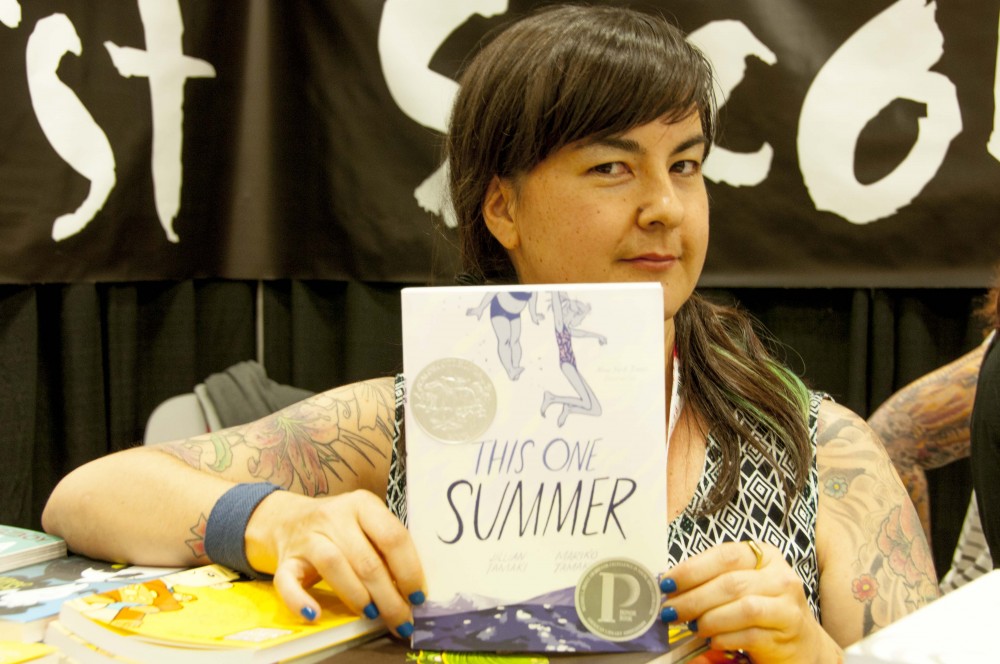
Mariko Tamaki
By Nick Eskey
Mariko Tamaki is a Canadian born artist of mixed Japanese and Jewish descent. In school she studied literature and writing, later on publishing the book “Cover Me,” as well as graphic novels “Skim” and “Emiko Superstar.” Her recent work is another graphic novel entitled “This One Summer.” Jillian Tamaki, Mariko’s cousin, did the illustrations for both this novel and for “Skim.”
“This One Summer” gives a glimpse into the life of two young girls as they spend one summer at a cottage by the beach. We get to see them learn and experience new things, as well as see the contrast between lives of adults and kids. During this year’s San Diego Comic-Con, I got to sit down and talk about this book with writer Mariko Tamaki. Unfortunately, Jillian could not attend.
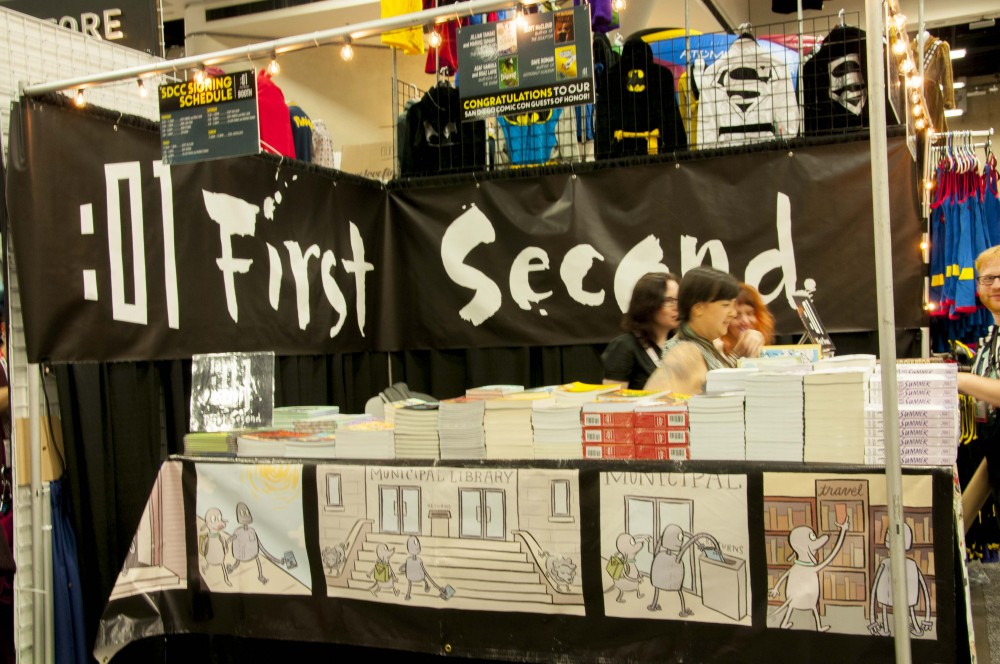
The First Second booth at San Diego Comic-Con 2015
How long have you been doing comics?
The first comic I did was with Jillian. It was a mini-comic called “Skim.” I believe it was the early summer of 2008 I did the first mini-comic for a literary magazine in Canada called “Kiss Machine.” So… this woman, Emily Pulari, commissioned these mini-comics from women who never really had a lot of experience with comics. So we did a mini-comic through that. It’s kind of like a “test case.” Kind of like a low pressure to try something out. So we did the mini-comic of “Skim,” and that got purchased by “Groundwood Books.” And that was our first graphic novel together. That was my first work in comics.
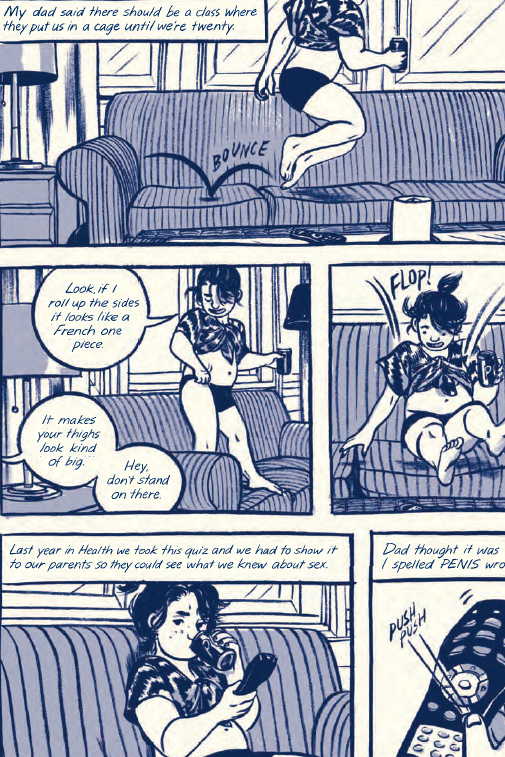 Did you ever think you’d get into comics?
Did you ever think you’d get into comics?
I had no aspirations to work in comics. But I always really liked working on collaborations. I’ve actually done a lot of theatre, and I’ve done a lot of performance art, which for me was like a more accessible version of theatre. So I’ve done a lot of actors work, and a lot of work in sort of feminist collectives and stuff. I was really into the idea of working with another artist than I was in comics per say. But I would say now that I’ve done comics, I think that they’re just an incredible medium for telling stories. The way that stories get told in my experience in comics is that it opens opportunities to tell [them] in so many different angles.
What were some of your ideas for writing this story?
I grew up in Northern Ontario, Canada. And every summer, you went to the cottage. So it was this like solid, integral part of my childhood… When it comes to comics, especially with this one, I thought of the atmosphere. I felt the background would be a good setting for a story. And I’m also kind of obsessed with transitional moments. So for me, the idea of being these young girls, and having this chunk of their lives, and analyzing that part, and all the sort of changes that would happen, even if [those changes] were all going to be during this one summer of their lives… it was something I wanted to show.
Would you say this mirrors any of your life?
Well I use to go to the cottage, but I didn’t have any of those challenges. I used some things as a beginning point, and created something fictional from that. Obviously I was a young girl at the cottage, and I had the fat young friend there too, but the characters are not really that connected to my life. The experiences that they have are not my experiences, aside from the fact that I also did go to Saint Joseph in Huron, which is the park that they go to in the book. Actually, Jillian and I as part of our research (that’s what we call it, “research”), went to Saint Joseph in Huron, went to the cottage, and spent a week in Nova Scotia which is I think one of the best places to write a book.
I think the dialogue is very down to Earth, and very easy to relate to. Is there anything that was hard for you to talk about?
During the initial draft, it was sort of a struggle to write the character of the mother because it’s hard to write somebody who’s not talking about what’s bothering them. And I think that’s so much of what Jillian brought to that character in terms of the details. Even the t-shirts that the mom wears have all these details that kind of build up that character. And we sort of went back and re-edited [her] a lot, because who wants to read about this upset mom who’s just having a bad day? I think that’s like the archetype of the “pissed-off-mom” from like ancient times on. And we wanted to see the layers of that experience. That was a really challenging thing to write, and it ended up being one of the more intriguing stuff. For whatever reason, the writing for Wendy and Rose was for me kind of easy. Their banter was just fun and easy, and it’s hard to write for someone that’s just not pleasant… it’s hard to lovingly write that.
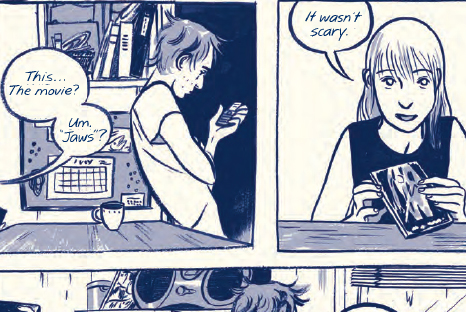
The kids seemed to be able to live in the moment, where the older characters were concerned with other things. How was it to show that dynamic of the two?
My archetype for stuff like that has always been the “Roseanne” show. It’s about the kids, and it’s about the adults. And the problems of the kids are not entirely linked to the adults, but their completely meshed. It’s like you have these people in this microcosm and their like push-pull on each other, where they’re struggling with the same struggles. So for me, I think it’s that kind of step forward from “Skim” to this book. That challenge of really creating a story that’s not just about the kids in this little bubble; to see these layered connections between the kids in the town, these kids in their respective homes, and all other different relationships. To me some of the most interesting scenes are the ones were something of the adults reverberate to the kids; their parents get into a fight, and that trickles down from the parents and then to the kid. And I think that sort of chain reaction is a super interesting one… It’s great to see someone on an adventure, fighting for their family or what have you, but at the same time most of our reality as teenagers is connected to our parents.
It really is interesting seeing these kids’ “bubbles” being formed and shaped by their parents.
It’s like a book about trying to be an adult, just as much for the adults as it is for the kids. These parents are trying to be adults, they’re trying to do the right thing. These teenagers are trying to be adults. And it’s all these varying groups of people that have this notion of what it means to be a grownup, and that depressing challenge of it being out of your reach.
Have you found yourself open to other avenues because of your exposure to graphic novels?
I ended up doing this short film called “Happy Sixteenth Birthday Kevin,” which is a movie about a sixteen year old Goth boy, but the cast is like me and my 30 year old friends. So I did that, because comics showed me how much I love dialogue, and I try to incorporate that as much as I can in the work that I’m doing.
“This One Summer” is available now. You can buy it online, or at your local book store.

By:
Heidi MacDonald,
on 2/13/2015
Blog:
PW -The Beat
(
Login to Add to MyJacketFlap)
JacketFlap tags:
Breaking News,
mariko tamaki,
Jillian Tamaki,
Skim,
Top News,
this one summer,
Awards,
Interviews,
Cartoonists,
Culture,
First Second,
Add a tag
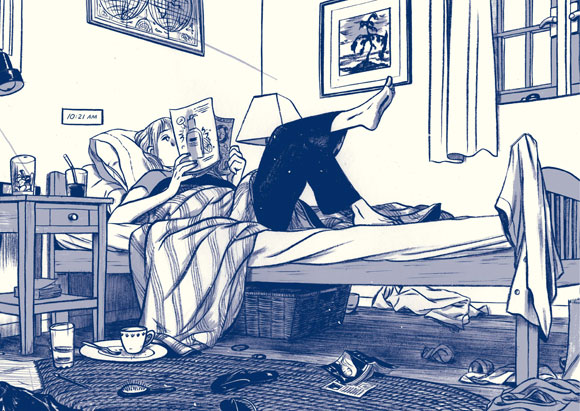
By Harper Harris
Mariko and Jillian Tamaki‘s This One Summer was one of the most highly acclaimed graphic novels of 2014, popping up on a great number of top ten lists as well as winning an Ignatz Award for Best Graphic Novel. To say it was an attention grabber for the already heralded Canadian creators is an understatement.
Just last week, this tale of two childhood friends on the cusp of adolescence was awarded with the prestigious Caldecott Honor, being the first ever graphic novel to do so, along with the Printz Honor (and joins Gene Luen Yang‘s Boxers & Saints as the only other graphic novel to notch that award as well).
Mariko and Jillian were kind enough to join me for a brief Q&A regarding the recent wins and the creative process on this landmark work.
Where were you each when you learned you won the Caldecott Honor? Who called whom?
Jillian Tamaki: I was in bed.
Mariko Tamaki: I think we eventually texted each other about it.
Is there a sense of accomplishment or “I’ve made it” for winning such a prestigious award? Jillian, how does it compare to your Eisner nominations or the Ignatz award that This One Summer also received?
JT: The feeling is one of gratitude. I’ll never felt like “I’ve made it!” until I’m like a hunched-over old person still making things.
Is it more gratifying to get recognition outside of the world of comics, which you’ve done multiple times at this point?
JT: Both are gratifying. Honours granted by librarians are special to me because it represents a knowledgeable, discerning audience that actually works with young people. Honours granted by comics people are special because it means perhaps I am creating something of value within the medium.
Were you relieved that you both got nominated for this award, rather than one or the other as in some past awards?
MT: When one of us gets nominated, I generally see it as a misconception of how graphic novels work. So, yes.
Do awards matter to you? I hope that’s not a weirdly loaded question.
JT: Um, they are nice, yes. Especially when there is money attached, because comics are not lucrative. But I try to not let outside validation determine the micro and macro decisions I make as a creative person.
MT: I guess awards help sales. There are many awesome comics and books out there that have not been nominated, so we’re in good company either way.
This One Summer ended up on many top ten lists for 2014…how does it feel to have one of the most critically acclaimed OGNs of the year among fans? Is it rewarding to see that fans of more mainstream comics are picking up and really enjoying works like yours?
JT: Of course!
As cousins, were you making comics as kids together? When did you decide to pursue sequential art collaboratively?
MT: We lived in distant cities as kids, so there was little comics making. It wasn’t until we made our first mini comic of Skim back in…2006 (?) that we started working together.
How long has this idea been gestating, and how long did it take to actually script and illustrate This One Summer?
JT: It took probably 3 years in total. It took a year of solid work to do the final artwork.
MT: Roughly 6 months to script. Plus changes.
What was your working process on This One Summer? Especially since I understand you don’t live near each other? Was there an initial script first and then an art stage, or was it done in a more section by section basis?
JT: We Skyped a lot. Mariko scripts the dialogue with occasional actions. I do a sketch version. We edit it together, a lot. Then I do the final art.
Where were your individual high and low points in the creative process of this book? Were there any parts that drove you crazy or were difficult to pull off?
JT: The most difficult part was the editing of the sketch phase. As it is with any book, I’m sure.
When I started reading This One Summer, I almost thought it was autobiographical…do either of your personal experiences play a role in the story? Were any of the designs of the characters based on real people?
MT: Nope. There is an actual cottage area that inspired TOS, up in Georgian Bay, Ontario, which I highly recommend people visit.
What is it about the adolescent stage of life that attracts you?
MT: I think most people spend their whole lives trying to figure out how and what to be. As I understand it, it’s not something that stops with adulthood. I think adolescence is interesting because it’s the start of this process. Everything is just that much more on the surface that it is when you’re an adult.
I love how you use Rose and Windy watching horror movies as a kind of metaphor for seeing the world in a more adult way…are you big classic horror movie fans, or how did that aspect of the story develop?
JT: No, I am a chicken. It was easy for me to draw the freaked-out kids.
Your capturing of the pre-teen voice and body language is wonderful…where do you pull that from? Is it based on your memories, or did you embark on any research?
JT: I am fascinated by the storytelling potential of bodies. We are very attuned to what they are communicating and I like to stretch that to effect. Sometimes I get very hung up on tiny details that I’m sure no one will see, but I think it adds up to an overall sensitivity.
MT: I am a chronic eavesdropper. Although the other day on the subway I was pretty sure some kid called me out for doing it so, I’m going to have to learn to be a little less gleeful listening to teenagers talk.
Rose’s family is fraying apart for much of the book. Why was it important to highlight the onset of familial strife, particularly seen from the eyes of a younger character?
MT: Who doesn’t have a little familial strife in their lives these days? It would seem kind of weird to me not to include it, whether writing about kids or adults.
This One Summer is considered to be all-ages, but there are different elements that clearly resonate with adults, which sort of mirrors how Rose is beginning to see the world as well. Who do you feel is the intended audience for the book? Or do you feel like This One Summer is fairly wide-ranging in its appeal?
JT: I only think of a few ideal readers when I work on the book. Some of those readers are real people, some are imagined. They’re usually not young kids. Some are teenagers. Most are my age.
MT: I think a books audience is self selecting. I don’t see a 10 year old reading this book cover to cover. Beyond that I think the idea is to write about not for.
What made First Second your choice of publisher, and why return to them after Skim, specifically?
JT: Groundwood, which published SKIM, put out TOS in Canada, and they have done a wonderful job. First Second made sense in that they had very strong ties to the American library system, in addition to the Macmillan network. But I think it has been excellent having both publishers, as Groundwood can prioritize the Canadian industry. After all, we are Canadian authors and the content is largely Canadian.
How are your next individual projects coming along? Mariko, I understand you’re working on a new YA novel, and Jillian it sounds like you’ve got some more “irons in the fire” in addition to your work on Adventure Time.
JT: My webcomic “SuperMutant Magic Academy” comes out in book form in April from D&Q. Also in April, Youth in Decline is publishing a short story of mine called SexCoven. It will be part of their “Frontier” series.
MT: My next prose YA book, Saving Montgomery Sole, will be released by Roaring Brook/Penguin Canada in Winter 2016.
This One Summer is available through First Second and on sale at your local book retailer
By:
Bianca Schulze,
on 2/2/2015
Blog:
The Children's Book Review
(
Login to Add to MyJacketFlap)
JacketFlap tags:
Caldecott Honor Books,
Mariko Tamaki,
Clarion Books,
Jon Klassen,
Dan Santat,
Mac Barnett,
Medal Winners,
Teens: Young Adults,
Barb Rosenstock,
Best Kids Stories,
Caldecott Medal Winners,
Most Distinguished American Picture Book,
ALA,
Ages 4-8,
Picture Books,
Book Lists,
Yuyi Morales,
American Library Association,
Candlewick Press,
Gift Books,
featured,
Caldecott Award,
Eerdmans Books for Young Readers,
Roaring Brook Press,
Award Winners,
Lauren Castillo,
Knopf Books for Young Readers,
Mary GrandPré,
Jen Bryant,
Melissa Sweet,
Little Brown Books for Young Readers,
Add a tag
Randolph Caldecott Medal Winner
The most distinguished American picture book for children, announced by the American Library Association.
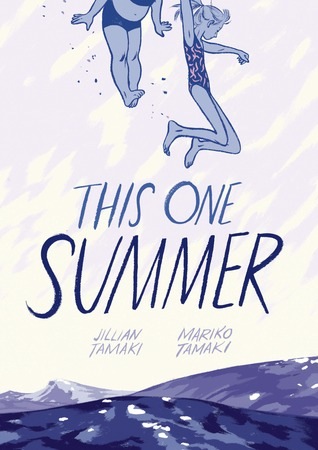
Another win for a graphic novel as Jillian Tamaki won canada’s Governor General Award : for This One Summer in the Children’s Literature Illustrations category. This is a prestigious Canadian literary award, and its the first win for a graphic novel, although cousin Mariko Tamaki was nominated for their previous collaboration, Skim, and Mariko was nominated in the Children’s Literature category this year. Jillian gets the hometown hero treatment from the Edmonton Journal (she’s a native of Calgary.)
It’s the first Governor General nomination for Jillian Tamaki but, strangely, not the first time her work has been nominated. There was controversy back in 2008 when Skim, the first book she created with her cousin, was nominated in the text category but not for illustrations. Tamaki argues that separating illustration and story into two categories for comics does not make a lot of sense, suggesting that it may be time for a separate category for graphic novels.
“It’s the same strange divorce of text and image for this one as well,” Tamaki says. “I think we are both creators of the book. You can’t read a comic without either component, it won’t make sense. It’s something I will always be addressing when talking about the award. But I am completely flattered by the honour and will be sharing the prize with my cousin.”
The National Book Awards ceremony is tonight where Roz Chast’s Can’t We Talk About Something More Pleasant is a finalist. Fingers crossed!
[Via Comics Reporter]
As Summer 2014 starts to break onto the horizon, one of the first big launches of the year sees Mariko and Jillian Tamaki working together for a new graphic novel, This One Summer, published this week through First Second.
A story of two girls, Rose and Windy, This One Summer is a tale of growing maturity, of dealing with the oncoming threat (or pride) of adulthood. It’s also a gorgeous, lush piece of work, with the creative team completely in-sync as they go about creating a memorable, surprising holiday experience for the two characters.
To find out more about the book – which I’m purposely not explaining to you in too much detail because I don’t want to spoil anything – I spoke to Mariko, who writes, and Jillian, who pencils; about the book what it’s like to work together, and how This One Summer came about.

Steve: What made you want to tell this specific story? What was it about the idea, or characters, which really struck you as something you wanted to explore?
Mariko: I’ve always wanted to do a summer story. Plus the cottage is such an interesting space. It’s not home, but you’re with your family. It’s your vacation spot but it’s someone else’s every day. The rules are totally different because you’re not at school. Even the landscape, you know? With the trees and the lake and the stars and everything. It’s a little magic.
Steve: This marks, I believe your first work published through First Second. How did they come to be involved with the project?
Jillian: I’ve actually been in informal contact with Mark since around 2004. Before First Second even had a name or before we had published Skim or I’d moved to New York. He had seen some of the illustrations that I had done for the New York Times Op-Ed––some of my first jobs ever after graduating art college––and thought my work seemed suited for comics. I was only making minis during that time.
During one of my trips to New York to visit my boyfriend (who was attending SVA), we met for lunch and had been in touch on-and-off since that time.
Steve: When you first start work on a new project, do you find that you start off focusing on the story, or focusing on characters, or both?
Mariko: For me it starts with character. I do a lot of writing (random stuff) to figure out who the characters are before I get started on a script. I write a lot of letters and just stream of conscious poems and whatnot to figure out what the characters think of each other, what they’re afraid of, stuff like that. I think it’s essential to understand who you’re writing. If you understand your character, you understand what they will do when your plot happens.
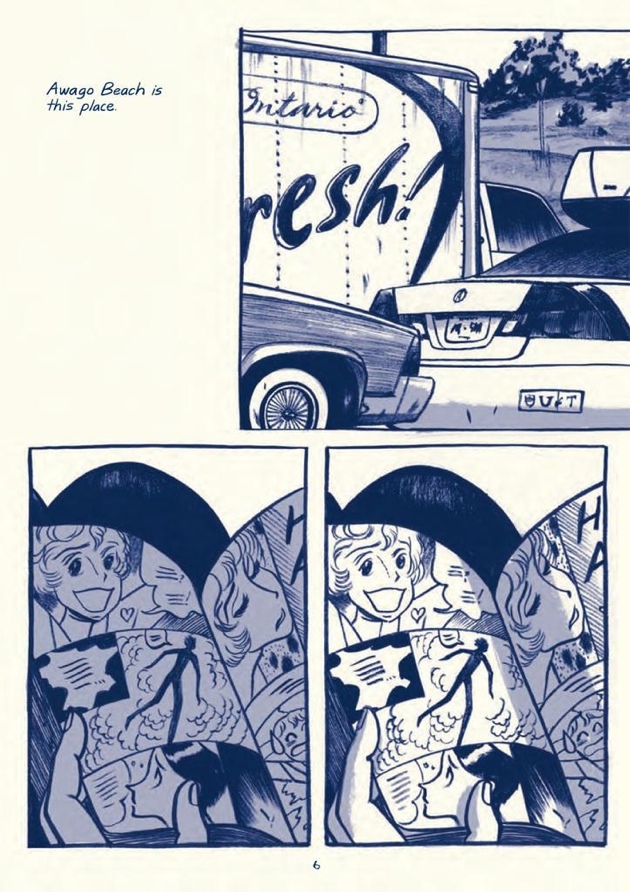
Steve: The story follows two girls, Rose and Windy, two childhood friends whose families go on holiday together every summer. It would be tempting to assume that elements of the story draw off some of your own experiences growing up…. would that be fair, though? Does the story draw on any elements of autobiography for either of you?
Mariko: I went to a cottage a lot like this one, but the characters in this book are very different than the people that populated my summers as a kid. I really tried to pull in a diversity of kids and adults and situations to tell this story, a lot of which were more inspired by people I’ve met as an adult than the people I knew when I was a kid. It’s a lot easier to observe kids as an adult than it was as a kid.
Jillian: I didn’t grow up going to the cottage. My family didn’t live near Mariko’s; we were on the other side of Canada where we don’t really have that type of thing. What I was more pulling from was the emotional landscape. We took a fact-finding/reference-gathering trip to Muskoka, the area depicted in the book, before we started and that was the most influential thing, because I wanted the book to be very sensory.

Steve: The two girls feel like fully-realized teenagers of the moment, and their dialogue feels contemporary and authentic. How do you get into the minds of the characters, and put words in their mouths? Can it be difficult sometimes to write younger characters?
Mariko: I do a lot of teaching in high schools and I check in (aka eavesdrop) on kids all the time. I think the thing is less to try and write/talk like a young person, and more to try and remember where that character is in his/her life. In a way the adults can be harder to write, especially in this case, because their words are so much more thought out and calculated.
Jillian: My job is to support the dialogue, and add depth to what is being said. There’s actually quite a bit of latitude there because obviously a word or sentence can have infinite meanings depending on the timing, body language, expression, etc. Thankfully, Mariko is not too precious about the words; I can skew them different ways and she’s cool with it. She is an excellent collaborator.

Steve: Tonally, how did you approach the story, both in the writing and pencilling? Despite the young lead characters, you address a number of more adult issues and concerns with a real streak of honesty.
Jillian: Well, thanks. That’s a real compliment and something we hope to achieve. Neither of us, for better or worse, approaches a story with a particular demographic in mind. Mariko has a knack for pinpointing social zeitgeists, I think.
There are three distinct groups of people in the story: the two little kids, the townie teens, and the adult parents. To return to your question, I didn’t try to worry so much about “will a kid get some of this adult stuff?” I think a reader will interpret the three groups differently depending on his or her age– hopefully it creates a textured experience.
Steve: This One Summer feels like an exploration on adulthood or coming of age – with one girl pushing away from adulthood and the other moving towards it, and both looking at their parents from new perspectives. Would you say that the nature of “adulthood” is perhaps one of the core themes and interests of this story?
Mariko: I think this book is about adulthood but from the perspective of kids. I’ve started describing the book as anthropological research of adulthood conducted by kids. Which makes sense, because adults have such a huge impact on kids. You’re basically at the mercy of the adults around you when you’re young. Also you’re fully aware you’re supposed to BE an adult at some point, which makes them worthy of study.
Jillian: Adolescence is the time when you stop taking everything at face value, including your own parents.
Steve: How do you plan out the structure of a long-form work like this? Do you work on specific scenes you want to hit at certain points in the story, and then work backwards and forwards from them, or do you write in a relatively chronological style?
Mariko: Typically I start with the characters and I have a sense of the main turning points going into it, then I just try to work it day by day.
Jillian: Mariko and I edited a lot during the sketch phase. Much more than Skim.

Steve: Jillian, I believe you’ve said in prior interviews that you chose to have your art reflect the style of vintage manga. What motivated that decision? What do you think the style brings to this story?
Jillian: No, the art style does not reflect manga. Just the purple-y tone of the ink, which seemed to be prevalent in manga from the 60s – but I chose it because I thought it’d feel warm and unusual (and cool). I don’t consider manga a huge influence on my work (but there is some Miyazaki in there). The drawing in This One Summer is pretty workhorse-y in that I can capture a degree of realism, which was important to the story, but it’s also fast. I would not want to do a 360 page book in a put-on style!
Steve: At what point do you start storyboarding or pencilling the story? Does it tend to happen as the story is being written – allowing for moments where you decide to space out a scene or beat, and so on – or do you finish the script and only then start pencilling?
Jillian: Mariko scripts, then I sketch the thing out, and we went back and forth a lot. The story changed a bit after the sketches. But I don’t add a ton more than what’s in there. The constraint is fun.
Steve: How do you both find the creative process with one another, in general? Do you think being family makes it easier to work together and compromise when you disagree – or can it actually, at times, make it harder to create?
Mariko: I’m not sure if we have a familial connection to these kinds of stories. We do seem to have a similar sensibility around character and story. Maybe it comes from having similar dads.
Jillian: Mariko is a great collaborator, like I said. Not sure it has anything to do with being family.
What else do you have coming up, following the release of This One Summer? Do you have any future plans to work together again?
Mariko: At the moment I’m editing my next YA book (fiction, not a comic) and prepping a few new projects.
Jillian: Probably a collection of my webcomic, SuperMutant Magic Academy. Another not-announced mini-project. My Adventure Time episodes will come out! Illustration stuff.
As for working together: maybe!
-
Many thanks to Mariko and Jillian for their time. Thanks also to Gina Gagliano for arranging the interview. You can find Mariko on twitter here, and Jillian here. This One Summer was published yesterday, and should be available at bookstores and comic stores near you.
By:
Inderjit Deogun,
on 10/20/2011
Blog:
The Pen Stroke | A Publishing Blog
(
Login to Add to MyJacketFlap)
JacketFlap tags:
In The News,
Karma,
Razorbill,
Charles de Lint,
Mariko Tamaki,
Carrie Mac,
Hiromi Goto,
Cathy Ostlere,
Joseph Boyden,
The Lemonman,
The Globe and Mail,
Emily Pohl-Weary,
Lynne Missen,
Natasha Ferrill,
Penguin Canada Young Readers,
Razorbill.ca,
Scot Gardener,
Turtle Island,
Add a tag
What am I reading now? The Lemonman by Natasha Ferrill

Razorbill
On Monday, October 17, 2011, I was fortunate enough to interview Lynne Missen, Penguin’s newly appointed Publishing Director for Young Readers, regarding the launch of Razorbill in Canada. Our interview touched on what both Canadian and international readers can expect from Razorbill. And now, without further ado:
The Pen Stroke: When is the official launch date of Razorbill?
Lynne Missen: The launch of Razorbill is two-fold: Firstly, it will be marked with the paperback release of
Cathy Ostlere‘s
Karma. It’s a book about fifteen-year-old Maya who returns to her homeland of India after the assassination of Prime Minister Indira Gandhi. Secondly, at the end of January 2012 a social media platform will be unveiled.
TPS: How many books will be published under the imprint annually?
LM: There will be half a dozen original content books. In addition, there will also be the release of second editions.
TPS: What types of books will be published under the imprint?
LM: Razorbill will be mainly comprised of young adult fiction for ages 12 and up.
TPS: How did the decision to launch Razorbill come about?
LM: It came from the desire to have an authentic and compelling voice. For that reason, readers will see a wide range of books being published under the imprint.
TPS: How does Razorbill plan to set itself apart from other imprints?
LM: We plan on making Razorbill the go to list. The aim is to foster a logo that will be recognized and respected by both teens and adults.
TPS: I’ve heard that Razorbill will be publishing Joseph Boyden’s latest novel. Can you speak about that?
LM: We are really excited about this. Boyden’s book will be based on his short story
Turtle Island published in
The Globe and Mail in July 2011.
Turtle Island is about a young boy caught between the contemporary life of gangs and the struggle to come to terms with his Native heritage.
TPS: Can you shed light on some of the other authors you’ll be publishing?
LM: Scot Gardener, Hiromi Goto, Charles de Lint, Carrie Mac, Mariko Tamaki and Emily Pohl-Weary, to name a few.
TPS: With the increasing popularity of eReaders, will Razorbill books be made available as eBooks?
LM: Absolutely.
TPS: Earlier you mentioned a social media platform. Can you elaborate on what shape that will take?
LM: Razorbill.ca, a virtual community, will be a forum for readers and writers to discuss books as well as a platform that will allow them to share content and videos.
I would like to once again thank Lynne Missen for taking the time out of her

By: Beth,
on 11/6/2010
Blog:
YALSA - Young Adult Library Services Association
(
Login to Add to MyJacketFlap)
JacketFlap tags:
Conference,
John Green,
David Levithan,
LGBTQ,
YA Lit Symposium,
Mariko Tamaki,
Jillian Tamaki,
Malinda Lo,
Megan Frazer,
Lauren Bjorkman,
LGBT Literature,
Kirstin Cronn-Mills,
Christine Jenkins,
Micahel Cart,
Add a tag
The morning began with Michael Cart giving an overview of some of the important social and political events related to LGBTQ issues. Next, Cart and Christine Jenkins presenting a list of all of the books with LGBTQ content from 1969 to 2010. They booktalked many of these, highlighting some trends (resolution by automobile crash, melodrama, impossibly good looking gay men and the women who love them), the breakthrough books, and the real dingers. It was like being back in library school, taking a class on LGBTQ YA Lit, but it was compressed. If you want to spend more time with these books and these issues, check out Cart and Jenkins’ book from Scarecrow Press, The Heart Has It’s Reasons.
If you get your hands on their bibliography and were not in attendance, please note that this is not a list of recommended books. Some are good and some are not so good. During introductions, we each chose books from the list to highlight. Boy Meets Boy by David Levithan and Will Grayson, Will Grayson by John Green and Levithan got the most nods, along with the graphic novel Skim by Mariko Tamaki and Jillian Tamaki. Please add your own recommendations in the comments.
After lunch of sandwiches and delicious chocolate cupcakes, there was an author panel consisting of: Lauren Bjorkman, Kirstin Cronn-Mills, Malinda Lo, and Megan Frazer (hey, that’s me!). We talked about what brought us to write our books, the challenges we faced, and what we hope to see in the future. We compiled a list of links that are on Malinda’s site.
After the author panel, I had to dash to the Body Positivity and Fat Acceptance in Contemporary YA Fiction pre-conference (which I hope someone else blogs about, because when I came in they were sharing some awesome ideas and resources), so I cannot give a first-person account of the breakouts that occurred — if anyone else would like to chime in, please do.
If you are in Albuquerque but missed the pre-conference, you can still hear about LGBTQ issues today at 1:30 at the breakout session: The New Gay Teen: Moving Beyond the Issue Novel.


Well, here we are, continuing our week of Graphic Novel reviews! Here I have 3 reviews of totally unrelated books. Enjoy!
Garage Band Gipi
Giuliano’s father has loaned them a garage to practice in, as long as the guys stay out of trouble. Alberto, the bassist spends his time worrying about his father. Alex, the drummer is obsessed with Hitler and his aunt scorns Giuliano’s family’s wealth. Stefano, the singer, is the trouble maker, but his father has him in contact with a record label. They have the garage, they have the contacts, they just need to cut their demo tape when their amp blows. When they steal a new one, their troubles really begin.
Painted in a muted watercolor palate with frenetic black line work, Gipi’s artwork captures the bleakness of their lives along with the energy of their music. There are several full page desolate landscapes composed mostly of brown sky to show what these young men are trying to escape. The back pages contain several preliminary sketches and character studies.
Skim Mariko Tamaki, drawing by Jillian Tamaki
After reading
Emiko Superstar, I was really excited to read this.
The book explores depression, love, friendship, and finding yourself (or not) in a small tale about a high school that overreacts when the popular girl is dumped by her boyfriend who then commits suicide. The details of the plot are really not important, because it's the characters, the dialogue, and the art that really make this book pack a punch.
Black and white drawings (pen?) that appear to be hand drawn without computer help are evocative of the early 90s era of the story. I especially liked the full-page panels and the ones without borders. Excellent use of negative space.
Kin (The Good Neighbors, Book 1) Holly Black, art by Ted Naifeh
Rue's mother has been missing for three weeks and her father has just been arrested for murdering one of his students. Meanwhile, Rue is pretty sure she's going crazy because she keeps seeing weird things, like... faeries. Faeries that claim to be her mother's family.
I really wanted to like this, but I feel like the entire volume was just setting up the story that's going to happen in the later volumes. It was a little disappointing, but I have great faith in Holly Black, and there are a lot of interesting story lines to play with and I'm really hoping that it goes somewhere, because I think the later volumes could be really cool.
Also, I thought it was going to be in color. I don't know why I thought this, but I did. It's not.
Later this week: Fables, Jack of Fables, Sandman, and Rapunzel's Revenge! Stay tuned!
by Mariko Tamakiillustrated by Steve RolstonMinx / DC 2008When DC Comics decided to launch its line of graphic novels aimed at teen girls I thought they were on to something, especially when I saw that they'd taken on YA author Cecil Castellucci for their inaugural title, The Plain Janes. It was an awkward start, as the pacing of that first title seemed a bit off, but the story had heart and its
Well, grades have been posted, so it looks like I will graduate this weekend! Wahoo!
And now here are reviews of 3 of the final 4 Minx titles. I haven't read Token yet, and that's the last one. (But, um, if someone wanted to hook me up with a copy of that, I wouldn't complain. My library doesn't have it yet and the library that does won't ILL it to me. :( )
Emiko Superstar Mariko Tamaki and Steve Rolston
It's shaping up to be the most boring summer in history for boring geek girl Emiko. Her friends are off at camp and she's spending all day babysitting a small drooly baby for the all-American picture-perfect couple. *yawn* Then she discovers Freak Show, a variety cabaret that she might be a little too normal to be hanging out at, but it's the most exciting thing going on. Maybe... maybe she could perform, too? Be a little freaky? Then when she finds the diary of the woman she's working for and starts to see that maybe the couple isn't as perfect as they look. With that information, Emiko has an idea...
LOVE LOVE LOVE LOVE LOVE LOVE LOVE this one. It's quiet on the surface--Minx novels are pretty short after all, but there is SO MUCH going on underneath. Just the right amount of angst. Emiko is a believable character that made believable choices and I never once wanted to whack some sense into her. My favorite Minx title. I must go find a copy of Tanaki's
Skim!
Janes in Love Cecil Castellucci and Jim Rugg
The P.L.A.I.N. Janes are back, and still trying to save through art. Our main Jane is caught between Damon, Miroslaw, or her new secret admirer. All the other Janes also have their romantic issues, trying to catch their interests’ eyes in their own ways—Theater Jane’s romantic letters, Polly Jane’s direct frankness, and Jayne’s scientific analysis. There are other love stories, too.
But there is the negative—Damon has community service hours to serve after New Years, and Officer Sanchez still thinks P.L.A.I.N’s art is vandalism. What’s even worse is the state of the world. Terrorism is still rife in Metro City, and an anthrax attack kills a friend of Jane’s mother. After the attack, Jane’s mom won’t leave the house, and leaves the mail on the lawn, too afraid to open it.
I thought the first Janes novel tried to do too much, and would have worked better as a regular novel as opposed to a graphic novel. This one, however, fits in the comics medium better. Fans of the
first novel will want to check this one out.
The New York Four Brian Wood and Ryan Kelly
Riley lives her whole life attached to her PDA Blackberry/iPhone thing, to the point where she lacks interaction with the flesh and blood humans in her life. After starting college and reconnecting with her estranged sister, Riley realizes she has to have some human contact, but it’s hard.
An interesting story with an ambiguous ending—and I am a fan of those. There are a lot of loose ends with the other characters that could have turned into serious subplots in a longer novel. I wish that this would be the first of a series, and we’d get a total of four books—one for each of Riley’s group of friends, but with the demise of Minx, it doesn’t seem likely. I'd be really into this if it were the first in a series, but as it will end up being a stand-alone, I'm a little disappointed.
 Little Pink Pup by Johanna Kerby
Little Pink Pup by Johanna Kerby  A Balloon for Isabel by Deborah Underwood
A Balloon for Isabel by Deborah Underwood Citizen Scientists by Loree Griffin Burns
Citizen Scientists by Loree Griffin Burns The Liberation of Gabriel King by K.L. Going
The Liberation of Gabriel King by K.L. Going This One Summer by Mariko Tamaki
This One Summer by Mariko Tamaki




















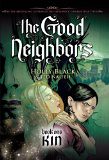
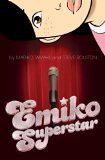
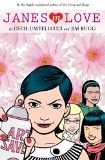
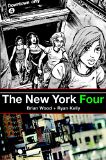
Correction:
” that This One Summer is a Caldecott Honor book, the highest honor a YA book”
The Printz award is for YA books.
“The Michael L. Printz Award is an award for a book that exemplifies literary excellence in young adult literature.”
The Caldecott:
“It is awarded annually by the Association for Library Service to Children, a division of the American Library Association, to the artist of the most distinguished American picture book for children. ”
The Newbery:
“It is awarded annually by the Association for Library Service to Children, a division of the American Library Association, to the author of the most distinguished contribution to American literature for children.”
This One Summer was a Caldecott Honor and a Printz Honor recipient. The same year, “El Deafo” was a Newbery Honor title.
How loud can I SIGH?
So, Mrs. Arbogast, do you really find this graphic novel objectionable or do you think people don’t show you enough attention.
HARD HITTING INVESTIGATIVE JOURNALISM!!!!!
…about kids reading something relating to real life.
Maybe parents should go and help their child select books.
Parent AND child will be at opening night of Deadpool. Classic Florida!